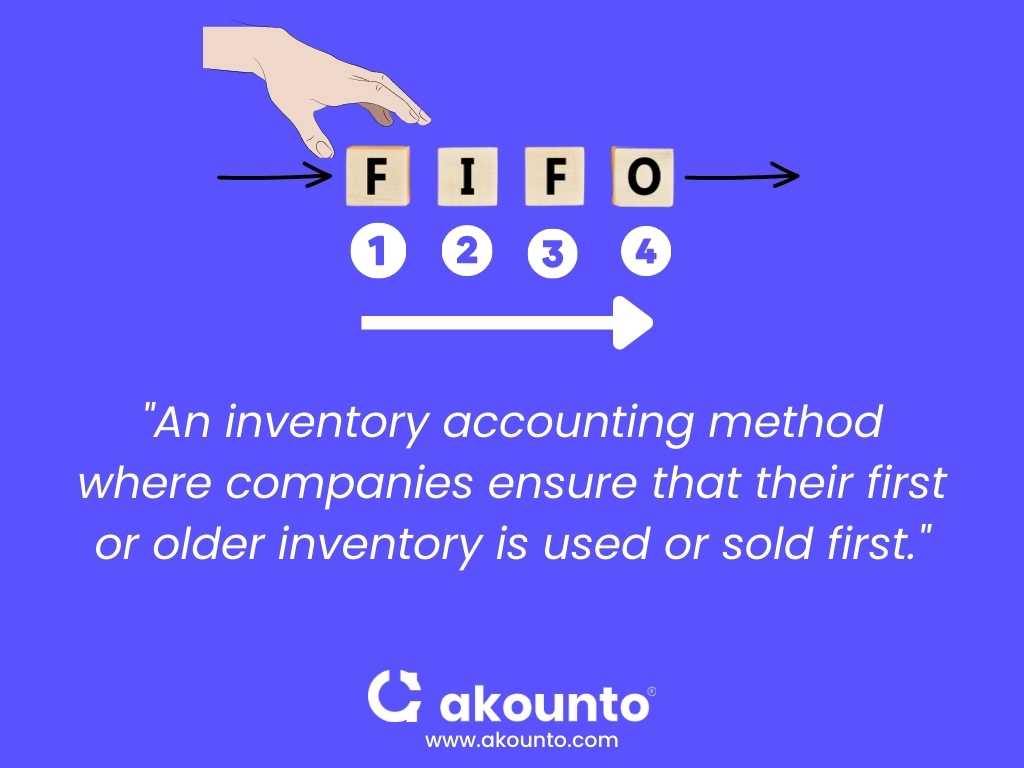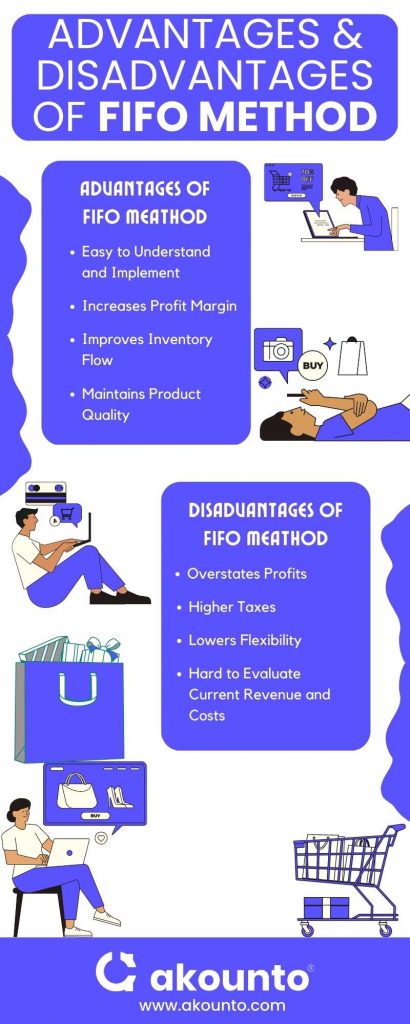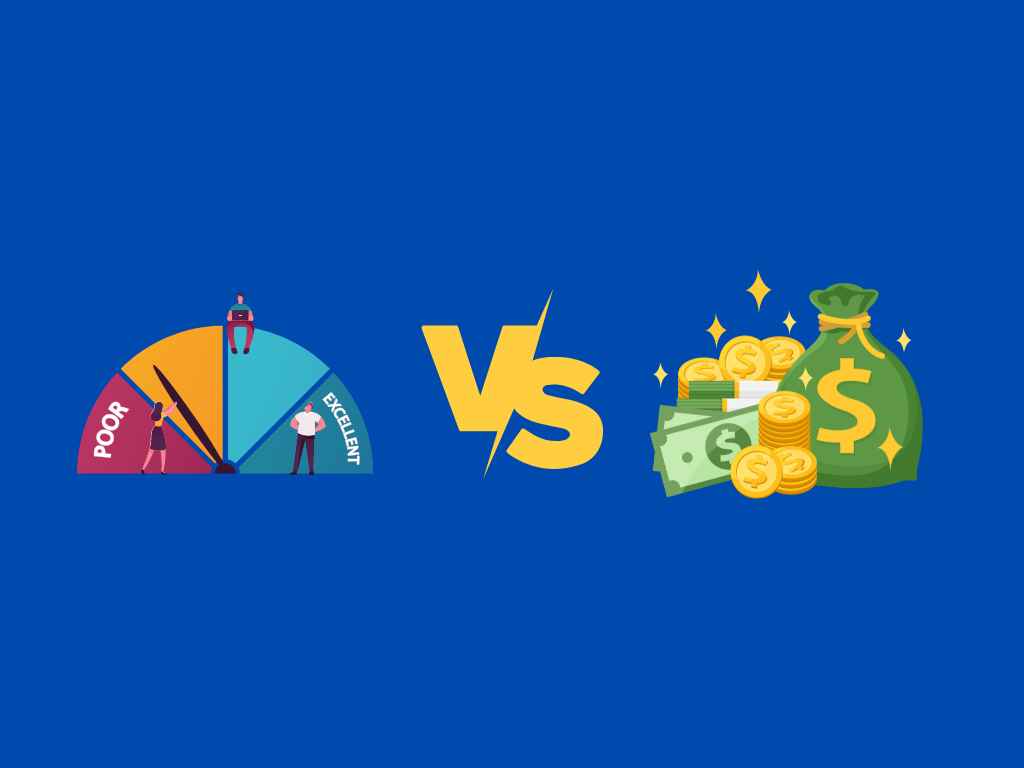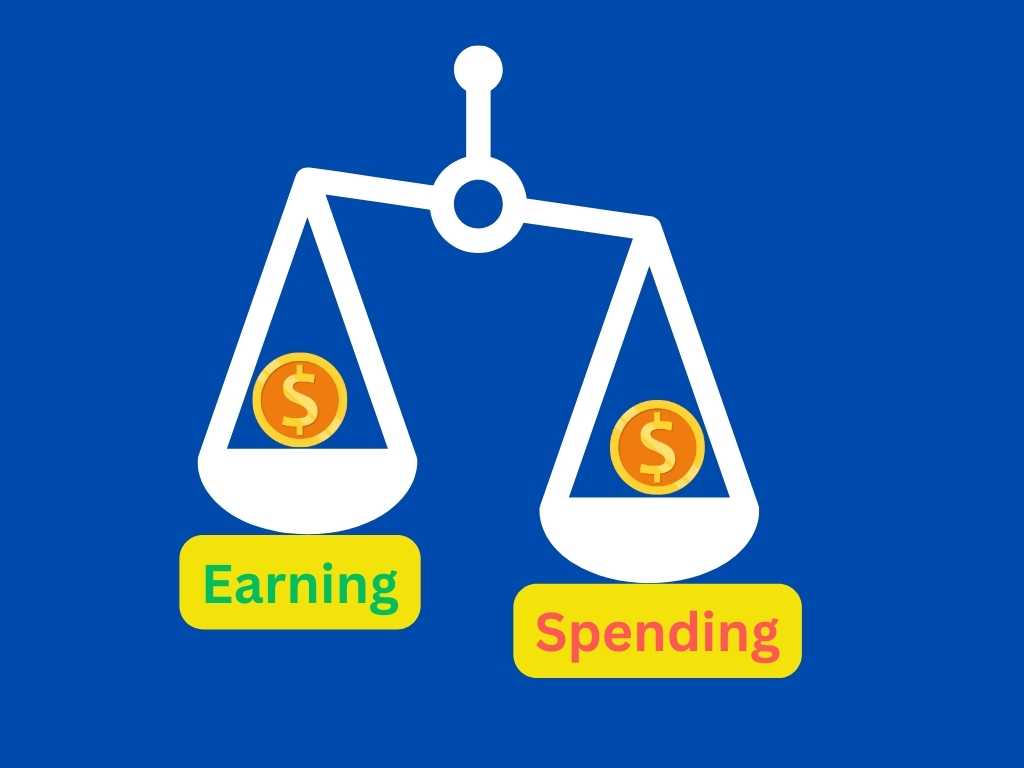What is FIFO Inventory Valuation Method?
First-In, First-Out (FIFO) is an inventory valuation method in which the oldest items are recorded as sold first.
The FIFO method helps determine the inventory value. It ensures that the oldest items or items purchased first are the first items to be sold. The cost of these oldest inventory items is recorded as the cost of the goods sold (COGS).
What’s covered in the article
In FIFO, a company uses or sells its inventory purchased first, and the cost of these oldest items will be higher than those purchased later. The main factor for assuming this is the cost of goods tends to increase over time due to macroeconomic factors like inflation, supply-chain hurdles, etc.
The FIFO concept aids in calculating the cost of goods sold (COGS) on the balance sheet of businesses, which signifies how much profit or loss the business has made.

The FIFO cost flow assumption dictates that a company uses the cost of the beginning inventory to calculate the cost of goods sold in an accounting period.
Businesses using the FIFO method should keep a proper inventory record. It includes the date of buying, cost of the items, quantity, etc. Keeping these records helps determine the COGS on the businesses’ income statement.
How Does FIFO Work?
The basic principle behind the first-in, first-out method is that the products that are added to the inventory in the first place will be sold first. Companies that follow the FIFO method ensure that their first or older inventory is used or sold first.
Due to inflationary pressures, there is always a risk that the cost of producing goods will increase over time. So, businesses that use the first-in, first-out (FIFO) concept tend to be more profitable, as their oldest items are sold first.
The first-in, first-out method is widely used by businesses that sell short-lived or perishable items like food, medicines, or other related consumer products.
Businesses use a formula to evaluate the cost of goods sold (COGS) using the FIFO method, which is given by:
COGS = Original units sold from the first batch (the initial purchase) x cost of each unit + Remaining units from the second batch x cost of each unit
This formula is applied for calculating the cost of the goods sold, starting from the older inventory to the newer inventory.
Requirements for FIFO to be Applicable
FIFO is the most widely used method by businesses, especially those operating in retail, food, and other related services. The inventory management concept ensures that the oldest product from the inventory is sold first.
Under GAAP, businesses can use three inventory valuation methods: FIFO, LIFO, and average cost. However, under IFRS, businesses can only use the FIFO method.
To effectively implement the first-in, first-out (FIFO) concept, one should make sure that the following requirements are met:
Detailed Inventory Tracking
Detailed tracking of products entering and exiting a company’s inventory is a must to use the FIFO method. The accurate tracking method and up-to-date inventory costs record ensure that the first item to enter the inventory is the first to go out.
Proper Labelling and Managing of Inventory
Proper inventory product labeling is required to use the FIFO method effectively. Properly labeling and organizing the products makes the oldest items easily identifiable and thus easy to go out from the inventory first. In addition, the labeling also shows the manufacturing or arrival date, which helps the company’s inventory management better.
Proper Employee Training
The employees should properly understand the FIFO concept and why it is important for a natural flow in the businesses. Ithelps the employees to keep accurate track of their inventory costs, as well as for labeling or organizing the items.
Inventory Audits
A regular inventory audit is required for the FIFO concept to work efficiently. It helps businesses identify any discrepancies or issues regarding implementing the cost account method. Besides, a proper audit also ensures that the first purchased products are sold or used in the first place, especially during supply chain woes.
Advantages & Disadvantages of FIFO Method

The FIFO concept could act as a double-edged sword if not understood properly. Like every other concept, it has some benefits and downsides. These include:
Advantages
- Easy to Understand and Implement: The process is easy to understand and can be seamlessly implemented for inventory management. Besides, the concept is considered more transparent, making it hard to manipulate FIFO-based accounts.Meanwhile, FIFO is also allowed by international financial reporting standards (IFRS), which makes it more convenient for businesses to implement the concept.
- Profit Margin: The FIFO concept usually helps in increasing the profit margin of the company. The statements show more profit as the oldest inventory items are the first to be sold.For example, a company bought 100 units of steel sheet at $2 in January. However, due to inflation, the cost of steel sheets increased to $4 the next month. So, if the company sells the items in February, it will profit more.Hence, this generally helps attract more investors, especially small business owners, due to the business’s higher profit margin and net income.
- Improves Inventory Flow: Most businesses prefer to sell the oldest items first, as they can lose value after being stored for the long term. FIFO helps in improving the natural flow by selling the oldest items first. It also shows the more accurate value of the company’s current inventory, as the stored items in the inventory are the recently purchased ones.
- Maintains Product Quality: FIFO reduces the risk of stock spoilage, obsolescence, or devaluation risk by ensuring that the oldest inventory is sold first. By selling the oldest products with shorter expiration dates from the inventory, the quality of the sold products is maintained, which also helps improve the reputation of the businesses.
Disadvantages
- Overstates Profits: The FIFO inventory method can mislead investors by overstating the gross margin in the financial statements. Due to the wide gap between the costs and revenue, this method often shows a higher profit margin for the company, especially during soaring inflation.
- Higher Taxes: There is a chance of higher net income in the FIFO method, and the company may have to pay higher taxes. Especially due to the potential inflation and rising prices, it overstates the profit margin of the businesses while increasing the tax burden for them.
- Lowers Flexibility: The cost accounting concept can reduce the flexibility of a business, as it restricts them from selling the oldest items from the inventory. This often results in missed opportunities for companies to sell more valuable items or products in high demand.
- Hard to Evaluate Current Revenue and Costs: Due to inflation, the price of the materials tends to fluctuate drastically over time. As the oldest items are sold first, it is hard to match the current revenue with the cost of the actual products.
Examples of FIFO Method
Example 1: Retail Shop RTL receives 100 packets of bread on Monday and 100 on Tuesday. So, RTL has 200 packets of bread in its inventory now. Now, the retailer orders 160 packets of bread on Wednesday. Using FIFO, how will RTL clear its stocks?
Solution: Following the FIFO concept, RTL will first include the 100 packets of bread purchased on Monday and the next 60 packets from the second shipment. As the older stock is cleared first, it reduces the chances of spoilage and potential loss for RTL.
So, the COGS will be (4 X 100) + (5 X 60) = $700
Note that the first inventory products cost is used in the first COGS calculation, i.e., 100 bread at $4 each and the remaining 60 from the second purchase batch at $5 each.
Example 2: ABC Supermarket purchased 100 cakes at $2 each on Monday. On Tuesday, it purchased 50 more cakes at $3 each as the price went up due to inflation. How will ABC Supermarket clear its stock and calculate the COGS using the FIFO method?
Solution: ABC Supermarket has 150 cakes in its inventory, of which 110 are already sold.
In this case, the cost of goods sold (COGS) = (100 X 2) + (10 X 3) = 230.
Example 3: TLB is a company operating in the e-commerce business. The company has five shipments waiting for ten days, three shipments waiting for seven days, and six shipments waiting for three days. Using the FIFO method, which shipments will be delivered first?
Solution: Using the FIFO method, TLB will prioritize the shipment waiting for the longest, i.e., five shipments waiting for ten days, ensuring efficient use of resources and timely delivery to its potential customers.
Other Inventory Valuation Methods
The valuation of inventory is essential for businesses to calculate the COGS and determine their remaining inventory value. Besides FIFO, there are other inventory valuation methods used by businesses, which are;
- LIFO method: In the Last-in, First-out, or LIFO method, the last or most recent item to enter the inventory should be the first to be used or sold. Businesses typically use the LIFO method during inflationary pressures, likely resulting in higher COGS and lower taxable income.The formula used in the LIFO method: COGS = (The number of newest inventory products x cost per unit) + (remaining units from the older batch x cost per unit)
- Specific Identification: Specific identification identifies the actual cost of individual goods purchased or added to the inventory. It uses the actual cost of the products to determine the inventory value and its COGS. While this method provides more accurate calculations, some find it time-consuming and claim that more detailed record-keeping is required.
- Weighted Average: Weighted average calculates the average costs of all the items present in the inventory. The weighted average costs of all items in the inventory help businesses determine the cost of goods sold and its remaining inventory value.
Conclusion
The importance of the FIFO concept lies in its ability to accurately evaluate the COGS and the inventory value. FIFO assumes that the inventory sold would comprise the first items to be added, which is also likely to happen in real life.
The concept aids businesses in better understanding their operating cost and informs them about product pricing, production, and inventories. Besides, it helps businesses determine the COGS and aids them in tax purposes. Notably, the cost of goods sold is an important metric in calculating the taxable income of any business.











